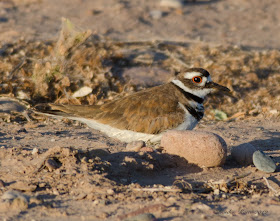http://arboretum.ag.arizona.edu/
Obviously when they created all these different habitats it also created a haven for a lot of wildlife, including birds. Anyone who is passing through this part of Arizona should make it a point to stop and check it out. You never know what you might find there as you walk the trails. It is a frequent place to visit for me and to round out my 3 day weekend, I travelled out to BTA with Ellen Hairston, one of my regular birding friends. One of the first birds we discovered was a juvenile Zone-tailed Hawk sitting in one of the pine trees. These birds are most often seen soaring the thermals and look very similar to a Turkey Vulture. Since Turkey Vultures do not attack live animals and only feed on carrion, the Zone-tailed Hawk can soar with the vultures, and their prey think they are safe as they appear to be vultures and of course the Zone-tailed Hawk can sometime find easy prey. This was the best close-up view that I have ever had with a Zonie and it seemed to have very little fear of us.
Zone-tailed Hawk
As we traveled the higher elevation path with Ayer Lake as our next destination, a Northern Cardinal put in an appearance singing from an Ocotillo limb. Most generally, these birds are found down in the foliage near the stream, so it seemed just a little out of place on the high desert trail.
Northern Cardinal
As we ventured around the main path, which is about 1 ½ miles in length, we worked out way to Ayer Lake. While it is a small lake, it sometimes has a surprise or two in it. This time was the first time I found a Great Blue Heron at this lake. I am sure they have been there before, but it seemed a bit out of place. Also had a Green Heron in this small lake, but alas, it kept to the other side of the lake and I had to settle for photos of the Great Blue Heron only, which is still nice bird to find.
Great Blue Heron
Working our way downhill from Ayer Lake, we found a Broad-billed Hummingbird actively sipping nectar from some spent Agave blossoms. This is one of the most attractive hummingbirds and their red bill is an easy way to identify them from other hummers.
Broad-billed Hummingbird
And a short distance from this we found a Hooded Oriole singing from the top of a palm leaf.
Hooded Oriole
The prize of the day was found in the Demonstration Garden, a Varied Bunting. This is a bird more commonly seen in Mexico, but with a few reports in Arizona, New Mexico and Texas. This is a bird I had never seen before, so it was a welcome addition to my lifetime list. Even though it is not a great photo, it is clear enough to see the beautiful colors this male has and a photo that I can live with since it is a fairly rare find in Arizona. With luck, maybe there is a pair of them at BTA and nesting would and rearing some young at this location would be a really big plus.
Varied Bunting
Lesser Goldfinch
Boyce Thompson Arboretum is a place that will return to very frequently as it is beautiful with flowers, abundant bird life and some amazing wildlife when one is alert and looking.




















































